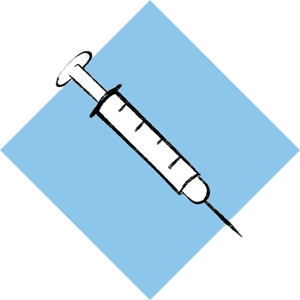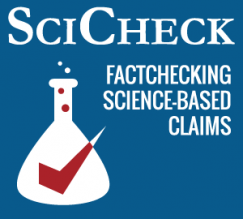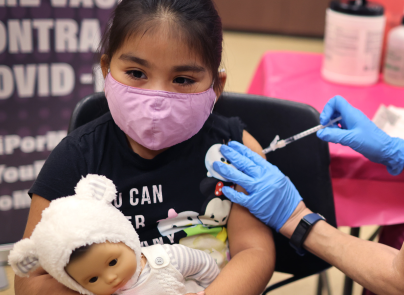Benefits Outweigh Risks of Pediatric COVID-19 Vaccine, Contrary to Posts Misusing VAERS Data
SciCheck Digest
The Vaccine Adverse Event Reporting System can detect possible safety issues in vaccines. Anyone can submit an unverified report, regardless of whether a vaccine is known to have caused the problem. Yet viral messages continue to misuse the VAERS data, and flawed calculations, to claim the Pfizer COVID-19 vaccine for children is unsafe and will cause many more deaths than it will prevent.


Full Story
As we’ve written several times before, social media posts and online claims have repeatedly misused and misrepresented the unverified data from the Vaccine Adverse Event Reporting System to make false and misleading claims about the safety of the COVID-19 vaccines.
 The Centers for Disease Control and Prevention and the Food and Drug Administration use VAERS as an alert system to detect potential safety problems with vaccines. All reports are accepted into the database without determining whether the event was caused by a particular vaccine. When experts see an unusual pattern of reports that could be a safety signal, they can then investigate; all reports of serious adverse events are reviewed. And, the CDC says, if someone dies after a vaccination, health care providers are required to report the death by the FDA, even if it’s not clear the vaccine played a role.
The Centers for Disease Control and Prevention and the Food and Drug Administration use VAERS as an alert system to detect potential safety problems with vaccines. All reports are accepted into the database without determining whether the event was caused by a particular vaccine. When experts see an unusual pattern of reports that could be a safety signal, they can then investigate; all reports of serious adverse events are reviewed. And, the CDC says, if someone dies after a vaccination, health care providers are required to report the death by the FDA, even if it’s not clear the vaccine played a role.
A disclaimer on the VAERS website warns: “The reports may contain information that is incomplete, inaccurate, coincidental, or unverifiable.” The website continues: “One of the main limitations of VAERS data is that it cannot determine if the vaccine caused the reported adverse event. This limitation has caused confusion in the publicly available data from VAERS WONDER, specifically regarding the number of reported deaths. There have been instances where people have misinterpreted reports of deaths following vaccination as deaths caused by the vaccines; that is not accurate.”
One of the latest online claims to misinterpret VAERS reports of deaths focuses on the Pfizer/BioNTech COVID-19 vaccine for children ages 5 to 11, which was authorized by the FDA in late October. The claim, which originated in an Oct. 31 post by Toby Rogers, who writes for Robert F. Kennedy Jr.’s anti-vaccination organization, Children’s Health Defense, is that more kids will die from the vaccine than will be saved from the vaccine.
“So, to put it simply, the Biden administration plan would kill 5,248 children via Pfizer mRNA shots in order to save 45 children from dying of coronavirus,” Rogers claimed.
Other websites are now spreading the claim, falsely saying that “CDC and Big Pharma Data Confirm” this.
Data from the CDC and Pfizer do not confirm this. Instead, the figures rely on distorting VAERS reports and using a problematic concept known as the number needed to vaccinate, or NNV, which is sometimes used to assess the benefit of immunization.
Pfizer’s clinical trial, which included 4,600 children, found the pediatric vaccine to be highly effective in preventing symptomatic disease and did not identify any serious safety concerns.
VAERS
The claim that the Pfizer vaccine “would kill 5,248 children,” comes from wrongly assuming all reports of deaths to VAERS for those ages 12 to 24 are accurate and attributable to the COVID-19 vaccines, and then amplifying it by a factor of 41, a disputed figure that comes from two researchers who claim it is the “underreporting rate” of events submitted to VAERS. Reuters has fact-checked a similar claim about deaths from the vaccines based on that underreporting rate.

An FDA spokesperson told Reuters that said the agency “strongly disagrees” with that analysis, saying there is no evidence to suggest that the number of reported deaths are underestimated to “such a large degree.”
The VAERS website acknowledges that underreporting is a limitation to this system. However, the “degree of underreporting varies widely.” Minor side effects, such as soreness at the site of injection, are often not reported. “On the other hand, more serious and unexpected medical events are probably more likely to be reported than minor ones, especially when they occur soon after vaccination, even if they may be coincidental and related to other causes,” the VAERS website says.
Rogers said he used reports of 128 fatalities in VAERS for those ages 12 to 24, because there wouldn’t be data for kids ages 5 to 11 since the vaccine had just been authorized for that age group.
When we searched the VAERS database on Nov. 23, we found 30 reports of deaths for the age group 6 to 17 and another 124 reports for the age group 18 to 29. But as we said, the VAERS reports are unverified, and everyone is encouraged to report any post-vaccination event, even if it’s unclear whether there’s a connection to the vaccine. As an example of this, two of the deaths among the 6-to-17 age group were suicides.
“Just because somebody reports death doesn’t mean that the vaccine caused the death. So we don’t use VAERS to determine death rates or anything concerning death,” a CDC spokesperson told us previously.
When a death is reported, the CDC investigates, using medical records, autopsy reports and death certificates. For example, the CDC says, “A review of reports indicates a causal relationship between the J&J/Janssen COVID-19 Vaccine and TTS, a rare and serious adverse event—that causes blood clots with low platelets—which has caused or directly contributed to six confirmed deaths.” As of Nov. 17, more than 16.2 million doses of the J&J vaccine have been administered in the U.S.
Thrombosis with thrombocytopenia syndrome, or TTS, has primarily affected females between the age of 18 and 49, and has not been identified with either mRNA vaccine.
As of Nov. 24, more than 196 million Americans have been fully vaccinated.
Other fact-checkers have written about similar claims that misuse VAERS data to claim the vaccine will kill more children than COVID-19. CDC spokesperson Martha Sharan told Reuters for a Nov. 16 story: “To date, there are no confirmed cases linking reports of death in children after COVID-19 vaccination to the COVID-19 vaccine.”
While no kids in the trial developed myocarditis or pericarditis, the CDC and FDA will be monitoring for this condition, as we’ve explained. They have occurred on rare occasions following vaccination with Pfizer/BioNTech’s adult vaccine, particularly in young adults and male adolescents, the CDC says.
The risk is likely to be lower for younger children, since classic myocarditis is less common in younger children and vaccine-related myocarditis appears to be less common in 12- to 15-year-olds than in 16- to 29-year-olds. Additionally, the pediatric Pfizer/BioNTech COVID-19 vaccine contains a third of the mRNA in the adult and teen formulation. Whether, or how frequently, vaccine-related myocarditis occurs in children will remain unknown until more children are vaccinated.
Number Needed to Vaccinate
As part of his faulty calculations, Rogers also makes incorrect claims about a metric known as the number needed to vaccinate, or the number of vaccinations that need to be given to avoid a single outcome, as a COVID-19 case, hospitalization or death.
In his posts, he falsely claims that the CDC is required to use NNV, according to an agency document.
“Your move CDC — your own Guidance document states that you must provide this number,” he wrote.
But the cited document doesn’t stipulate that NNV must be used, only that it may be used. And in fact, the document points out some drawbacks to using the figure.
“NNV to prevent a case of a particular infection-related sequela can be intuitive to medically-trained decision-makers, but may not capture all outcomes related to decision making and may not capture all aspects of a disease system,” it reads, “such as adverse events or in some cases benefits that occur due to indirect, or herd immunity, effects.”
A CDC spokesperson told us that according to the CDC’s Advisory Committee on Immunization Practices charter, recommendations for vaccines used in the United States include numerous factors, including disease epidemiology, vaccine safety, vaccine efficacy and effectiveness, quality of the evidence, economic analyses and implementation issues.
“The number needed to vaccinate (or NNV) is a method to help assess and present the ‘benefit’ in a benefit-risk analysis, but per the ACIP guidance on economic analyses, is just one of several outcomes that can be assessed depending on the specific policy question under consideration,” she said in an email. “CDC has frequently used a more comprehensive approach in analyzing and presenting the benefit-risk balance of the FDA-authorized and approved COVID-19 vaccines, one that is not limited to just NNV.”
The CDC did present a brief NNV analysis as part of its larger discussion of the risks and benefits of the Pfizer/BioNTech vaccine for children ages 5 through 11 during its Nov. 2 advisory committee meeting, as Rogers acknowledged in an update to his article.
In that analysis, depending on the level of SARS-CoV-2 transmission, 9 to 26 children would need to be vaccinated to avoid one COVID-19 case; 2,213 to 8,187 children would need to be vaccinated to prevent a COVID-19 hospitalization; and 3,777 to 11,226 kids would need to be vaccinated to prevent a case of MIS-C, or multisystem inflammatory syndrome in children.
Rogers contends that those estimates are “untethered from reality,” but cites an estimate for NNV in adults that is a republished version of an article that was retracted.
As we wrote before, when explaining why the original article was flawed, relying solely on NNV can be problematic because it is highly dependent on certain factors, including the time frame used.
Short time frames, Jeffrey Morris, director of the division of biostatistics at the University of Pennsylvania, told us, can greatly underestimate the benefits; other pandemic prevention measures, such as physical distancing, can also affect the number. And the success of a vaccine will make the metric appear worse. Morris called it “an extremely flawed measure.”
Another NNV estimate Rogers cites stems from a correspondence submitted to BMJ, formerly known as the British Medical Journal, from a retired pediatrician in Cooperstown, New York.
The journal appended an editorial notice for readers clarifying that it was an online comment from a third party, and not an article in the journal, adding that it is “attributed in a misleading way on certain websites and social media.”
Even if the NNV numbers for hospitalization or death appear high for children, there is no agreed upon threshold for interpreting what is too high, as a review article about the metric explains. The review also notes that it’s difficult to generalize from NNVs, since they are so specific to certain circumstances, and says that most NNVs “do not account for indirect or dynamic effects of vaccines, which are often significant.”
Both the CDC and FDA, along with their outside corresponding advisory committees, have evaluated the risks and benefits of the Pfizer/BioNTech pediatric COVID-19 vaccine, as they are understood now, and have determined the benefits outweigh the risks.
In its benefit-risk assessment, the FDA assumed the myocarditis rate in vaccinated kids 5 through 11 years old would be the same as in those 12 through 15 years old, which is likely to overestimate the risk. In various scenarios, it found the vaccine prevents more bad outcomes from COVID-19 than it causes, except for a scenario in which transmission falls to its June low point — just before delta become the dominant variant in the U.S. In that case, the FDA model showed more hospitalizations due to vaccine-related myocarditis than hospitalizations prevented from COVID-19. However, the FDA said the benefits still might outweigh the risks in that scenario because vaccine-related myocarditis is usually less serious than typical myocarditis.
Neither agency has concluded the pediatric COVID-19 vaccine will kill more children than it will save. On the contrary, their analyses suggest the vaccine will benefit children, and notably, many of the experts involved in making the shots available, along with others, have said they are eager to vaccinate their own children and grandchildren.
Editor’s note: SciCheck’s COVID-19/Vaccination Project is made possible by a grant from the Robert Wood Johnson Foundation. The foundation has no control over our editorial decisions, and the views expressed in our articles do not necessarily reflect the views of the foundation. The goal of the project is to increase exposure to accurate information about COVID-19 and vaccines, while decreasing the impact of misinformation.
Sources
“Selected Adverse Events Reported after COVID-19 Vaccination.” CDC. Accessed 24 Nov 2021.
“VAERS Data.” HHS. Accessed 24 Nov 2021.
McDonald, Jessica. “A Guide to Pfizer/BioNTech’s Pediatric COVID-19 Vaccine for Kids 5-11.” FactCheck.org. 5 Nov 2021.
“FDA Authorizes Pfizer-BioNTech COVID-19 Vaccine for Emergency Use in Children 5 through 11 Years of Age.” Press release. FDA. 29 Oct 2021.
“Fact Check-VAERS data does not suggest COVID-19 vaccines killed 150,000 people, as analysis claims.” Reuters. 4 Oct 2021.
“Guide to Interpreting VAERS Data.” HHS. Accessed 24 Nov 2021.
McDonald, Jessica. “Instagram Post Makes Invalid Comparison Between COVID-19 and Flu Vaccines.” FactCheck.org. 19 Feb 2021.
“COVID Data Tracker.” CDC. Accessed 24 Nov 2021.
“Guidance for Health Economics Studies Presented to the Advisory Committee on
Immunization Practices (ACIP), 2019 Update.” CDC. 11 Oct 2019.
Grusich, Kate. CDC public affairs officer. Email sent to FactCheck.org. 24 Nov 2021.
“ACIP Presentation Slides: November 2-3, 2021 Meeting.” CDC. Accessed 24 Nov 2021.
Fichera, Angelo. “Flawed Paper on COVID-19 Vaccines, Deaths Spreads Widely Before Retraction.” 2 Jul 2021.
Cunningham, Allan S. “Rapid Response: Covid-19 vaccine candidate is unimpressive: NNTV is around 256.” BMJ. 13 Nov 2020.
Ahmed, Hashim et al. “How and why researchers use the number needed to vaccinate to inform decision making—A systematic review.” Vaccine. 4 Feb 2015.
FDA Briefing Document, Vaccines and Related Biological Products Advisory Committee Meeting October 26, 2021. FDA.
“Vaccine Expert: Everyone on FDA panel would vaccinate their own child.” CNN. 9 Nov 2021.
McDonald, Jessica. “Pfizer/BioNTech’s COVID-19 Vaccine Formulation Tweaked to Improve Stability.” FactCheck.org. 19 Nov 2021.


